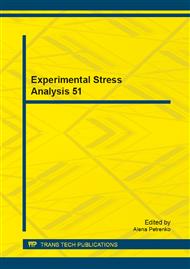p.3
p.9
p.16
p.20
p.26
p.32
p.36
p.42
Non-Destructive Inspection of Surface Integrity in Milled Turbine Blades of Inconel 738LC
Abstract:
Nickel super-alloys are widely used in aerospace as material for turbine blades. Unfortunately, their machining is difficult since mechanical hardening and, consequently, extreme tool wear occur. Casting can no longer meet the requirements for precision, hence, the castings are being ground or milled. In this contribution, a quality check of the milled surface by several surface integrity parameters is proposed with respect to the surface structural inhomogeneities caused by mutual effect of plastic deformations and thermal fields during the cutting process. Castings from Inconel 738LC were milled with cutting conditions chosen by Design-Of-Experiments method and the resulting surfaces were assessed by non-destructive X-ray diffraction methods in several areas corresponding to various cutter orientation and work-piece angle. Surface integrity was described by macroscopic residual stresses, microstrains, grain sizes and phase composition. Mostly, favourable compressive surface residual stresses were observed in the cutting direction, grain sizes were distinctively smaller when the tool axis was perpendicular to the machined surface.
Info:
Periodical:
Pages:
9-15
Citation:
Online since:
December 2013
Authors:
Price:
Сopyright:
© 2014 Trans Tech Publications Ltd. All Rights Reserved
Share:
Citation:


